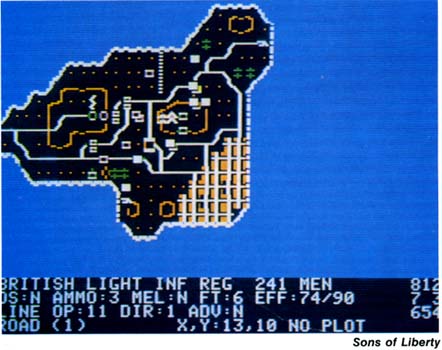
In case you haven't noticed, for the past couple of months we've been a little short on new software. Unfortunately, this has been almost exclusively an Atari 8-bit phenomenon, and one I'm at a loss to completely explain. In the first place, I have trouble understanding the vast consumer interest in the Sega and Nintendo game systems. I mean, they have great games, great graphics-but that's all there is to them. They play arcade games. They'd have a lot of trouble dealing with the more complex games available on any of a handful of computer systems. And don't even think of asking them to help you with that late term paper.
I can understand some shift of resources to the ST. It is representative of the machines of the future; machines that enable you to play games you could only dream about a few years ago. But machines like the ST also carry rather high price tags, putting them out of the reach of the vast majority of home users. At least some people consider them high. But such is not the case in the 8-bit category. Used machines abound, and a prudent shopper can set himself up for around $200. So what's the problem?
Evidently the manufacturers don't perceive that there is a market. Unfortunately, this sticks us Atari users in a catch-22 situation. In order to cast our consumer vote, we need products-products the publishers won't produce without a vote tally. So what's to be done? The answer is simple. We've got to cast our vote in an equally effective way. Write a letter.
When you see a game you think you'd like, and all you see is a Commodore 64 version, write the publisher and request it. If you've got a word processor, the form can be set up easily enough and used repeatedly. It will be recognized as a form letter, but the vote will count nonetheless. If you don't have a word processor, scrawl it out in your own handwriting. And remember to make it legible. If enough letters are received, action will be taken.
As for newcomers, you need not be concerned or frightened away from the Atari, as there exists a large catalog of great games from scores of publishers. In fact, sporadically over the last few months I've listed some of the best. It's mainly the veterans, like myself, who notice the drought of new products.
And while you're all sharpening your pencils, I'll tell you that at least one publisher is taking a chance, showing some sign of a semi-solid spine, by introducing a new war simulation. This is an intrusion directly into SSI's territory, and hence I'll pit this newest product against SSI's latest simulation. But before we begin the bloodbath, let's take a quick look at a utility for a program we looked at a couple of months ago.
Video Title Shop Graphics Companion II
Datasoft
19808 Nordhoff Pl.
Chatsworth, CA 91311
48K disk, $19.95
With Video Title Shop, a video camera, a VCR and, of course, your Atari, you are able to generate titles and graphics for your home movies and anything else you might record. When I tested it, I found this inexpensive program to be relatively easy to use and complete. And the release of Graphics Companion II makes this tool even more complete.
If you were tuned in earlier, you know all about the Title Shop, and if you weren't, then check out the October '88 issue of ANALOG Computing and become enlightened. Graphics Companion II is basically a data disk for use with the Shop. Thus it is not a stand-alone product. What it gives you is a number of additional fonts, borders and images which can be pasted onto screens. These latter two features are improvements not found in the original program.
That's really about the extent of this one. So, if you have Video Title Shop and want to go a little farther, pick up this companion disk. You might find yourself on your way to Hollywood before you know it.


Sons of Liberty
by David Landrey and Chuck Kroegel
SSI
1046 N. Rengstorff Ave.
Mountain View, CA 94043
48K disk, $39.95
Napoleon in Russia-Borodino 1812
by R. Steve Krenek
Datasoft
19808 Nordhoff Pl.
Chatsworth, CA 91311
48K disk, $24.95
These two war simulations, while coming from two very different companies, are nonetheless very close together in their historical time frame. It is for this reason that I present them to you this month. SSI's latest game, Sons of Liberty, is its first to cover our own country's Revolutionary War. This package has scenarios covering the battles of Bunker Hill, Monmouth and Saratoga. Datasoft's contender, Napoleon in Russia-Borodino 1812, predictably enough allows you to be Napoleon, one of the greatest military tacticians of all time. Unfortunately, this battle is one which led to the Little Emperor's downfall, due to the fact that he let the retreating red menace escape rather than completely destroying them. This game asks the question: Can you do any better?
Sons of Liberty is an introductory to advanced level game, which means that both novices and experts can enjoy re-creating epic battles in our country's fight for independence. Games can take anywhere from two to ten hours to complete, and play progresses along the usual SSI format. Each player (either or both sides can be human or computer controlled) takes turns moving and attacking, with the computer resolving the various conflicts instantaneously. In the basic game the joystick is used to issue orders (the preferred method) while the more advanced options require keyboard input. While this complexity yields more realism, it is at a cost: regular and lengthy disk swaps, which frustrate and slow play. It seems that 48K is just too small to hold it all.
Napoleon, on the other hand, is much more accessible to the novice player. A joystick is used for most input, with the Option, Start and Reset keys used to a lesser degree. Especially different is the way time is handled in this game. A game minute can equal 60 seconds or one second, and time flows continuously, in contrast to SSI's game, in which time (measured in turns) advances as moves are made. The practical difference is that Napoleon is more demanding; during your delays men are dying. Generally, though, the games play pretty much alike. In each you move units and attack the enemy. Unlike Liberty, in Napoleon the computer can control only Russia if you should fail to find a human opponent. Additional realism and difficulty are achieved by optionally taking into account troop fatigue and morale.
The graphics in Liberty, however, are superior to those of Napoleon. Slightly clearer and more detailed, their superiority is the result of the evolution of SSI's games for a number of years. There's nothing wrong with Napoleon's graphics, though, as this is strictly a judgement call. Noteworthy features of Liberty are the helpful on-screen prompts which continually remind the player of his options. Napoleon's screen is blank by comparison. Sound effects are about equal in both games.
The skirmish over the documentation has to be claimed by SSI. In Liberty it has produced one of its best packages, with two full-color, stiff cardboard maps and reference cards, a 51-page Historical Reference Guide and a 32-page rule book. The best feature of the latter is the seven-page tutorial section that starts even the computer novice on his way to a successful simulation.
Napoleon, on the other hand, is not as easy to learn. This is due to the lack of a tutorial portion of the manual, rather than inherent game design; because once the command structure is learned, the game is quickly mastered. Nonetheless, Napoleon does include substantial documentation. Its 37-page manual, while not as polished as SSI's, does present this complex game in a concise and more or less organized manner.
In conclusion, Napoleon in Russia is a fastpaced, simple simulation, ideally suited to the impatient novice. Sons of Liberty, on the other hand, has enough complexity to keep even the expert satiated for weeks, maybe months to come. For these reasons, each is recommended.

